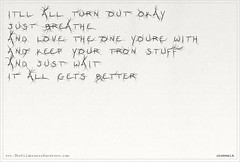Arcade Fire reinvent the music video for a digital age
If music videos were made for the web, this is what they’d look like.
Arcade Fire, one of the most successful Canadian bands in recent memory, has remained fiercely independent, distributing their own songs through independent label Merge and recording their albums in their own studios.
The video for their song We Used to Wait, taken from their latest album The Suburbs, was similarly self-produced and had no PR strategy other than word of mouth. It was designed as a GoogleChrome Experiment, one of dozens of multi-media projects funded by Google to highlight “the latest open standards including HTML5, Canvas, SVG and more…”
Instead of relying on footage of the band lip-synching their way through the song, filmmaker Christopher Milk has created an interactive, multimedia film that emphasizes the song’s message while making the viewing experience intensely personal.
At the beginning of the video, viewers are asked to input the address of the house they grew up in. The video begins with footage of a young child with a hidden face running through a darkened street.
Soon, images from GoogleMaps fill the screen, zooming into your childhood home, surveying your neighbourhood from above. These are quickly followed with a panoramic shot from the end of your driveway. It becomes clear that the child is a faceless avatar, an empty shell for you to explore your childhood home.

To top it off, you get to write a message to your childhood self in an exquisitely designed “spider-script” At the end, crows flood the screen to the sounds of a lonely piano. I might as well post this NSFW (Not Safe For Work) as it’ll probably make you cry and you don’t want to alarm your co-workers with a sudden flood of nostalgia.
Although the video itself has a few bugs and is a little jerky if you don’t shut down all the other applications on your computer, the idea of combining music, video and interactive web elements works surprisingly well. It also serves the purpose of re-introducing music videos to young people who are increasingly turning off their TVs in favour of online experiences.
It is a marvelous advertising vehicle for both Arcade Fire and GoogleMaps that subverts traditional advertising channels. It is a perfect teaser campaign for the new scripting language HTML5, which hasn’t been officially released yet. The video profiles HTML5 features, one of which is dispensing with the necessity to code videos in Flash for embedded playback.
The experience of imagining a song describing your own personal narrative is not new and artists have known for years that “blank slate” lyrics are ideal to hook into the emotions of listeners. But to expand this philosophy to filmmaking and interactive music videos serves to expand the scope of media’s reach.
New media creators, pay attention: this is the new music video.